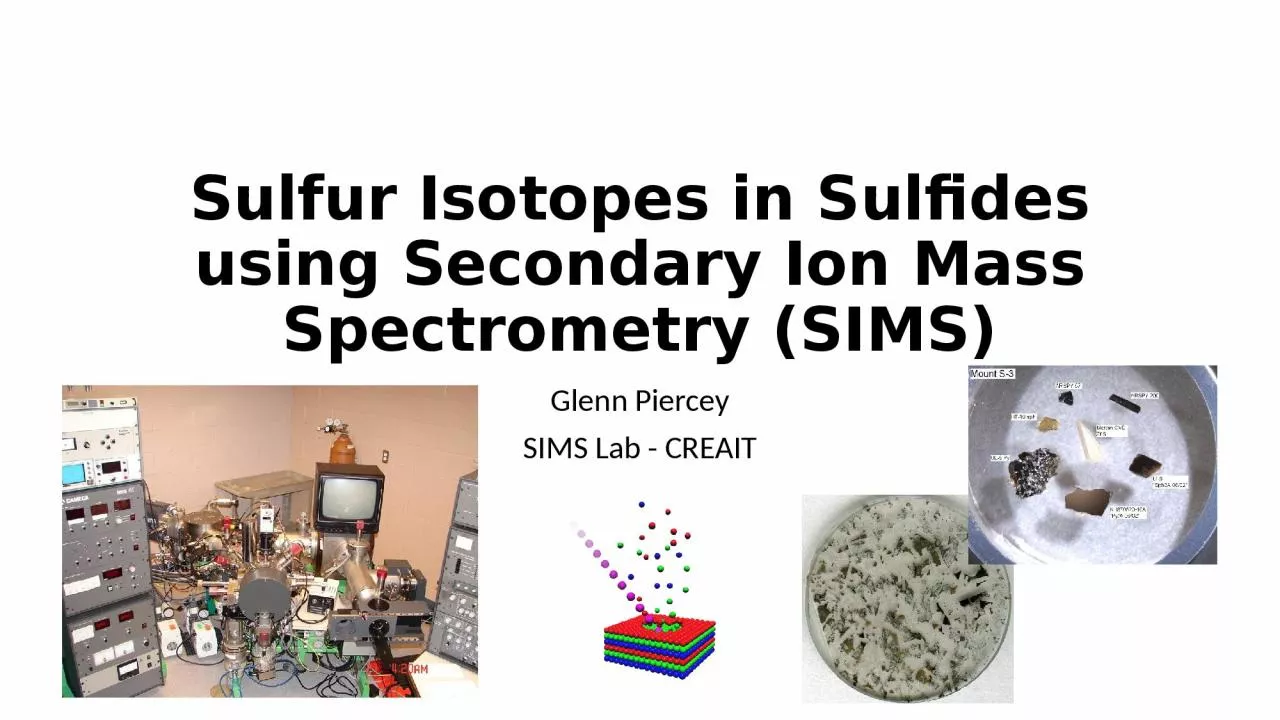

Glenn Piercey SIMS Lab CREAIT Sample Preparation SIMS Instrument Data Analysis Case Studies Lemarchant Deposit Central NL Ming Deposit Central NL Voiseys Bay Northern Labrador ID: 1025277
Download Presentation The PPT/PDF document "Sulfur Isotopes in Sulfides using Second..." is the property of its rightful owner. Permission is granted to download and print the materials on this web site for personal, non-commercial use only, and to display it on your personal computer provided you do not modify the materials and that you retain all copyright notices contained in the materials. By downloading content from our website, you accept the terms of this agreement.
1. Sulfur Isotopes in Sulfides using Secondary Ion Mass Spectrometry (SIMS)Glenn PierceySIMS Lab - CREAIT
2. Sample PreparationSIMS InstrumentData AnalysisCase Studies - Lemarchant Deposit – Central NL - Ming Deposit – Central NL - Voisey’s Bay – Northern LabradorSulfur Isotopes in Sulfides using SIMS
3. Sample PreparationDrill RigDrill CoreSelectingSectioning/epoxy/polishingSample gold coating
4. Sample Preparation: MappingSIMS Sulfide Puck4x Image Galena10x Image Galena
5.
6. Two sources used to produce primary ions:1. Duoplasmatron (DP)- uses oxygen to produce O- or O2+ ions.2. Cesium Ionization Source – produces Cs+ ions.Ions extracted from sources pass through a primary beam mass filter (PBMF) to remove unwanted species from beam.Electrostatic lenses and apertures control the intensity and size of the primary beam hitting the sample. Primary Column
7.
8. Mass SpectrometerElectrostatic Analyzer (ESA) and Magnet work to separate secondary ions by mass, charge and energy resulting in only ions of interest hitting the detection/counting system.
9. Video Tour of SIMS Lab (5 minutes) 500MB video
10. Sample Analysis: Sulfur Stable Isotopes34S/32S = ratio of heavy isotope to light δ34S = ‰ ( per mil) = difference in isotope composition of sample relative to international standard, VCDT.δ34S = R sample – R standard/ Rstandard x 1000
11. Sample Analysis: Standard DevelopmentSIMS, Solution ICP-MS, Laser ICP-MS, IRMSMatrix match, homogenousChalcopyrite = Norilsk (8.4 ‰ VCDT)Pyrrhotite = PoW1 (3.0 ‰ VCDT) = TrW1 (-2.6 ‰ VCDT)Pyrite = UL9 (16.3 ‰ VCDT) = KH87 (0.4 ‰ VCDT)Galena = HT10 (14.6 ‰ VCDT)Arsenopyrite = (ARSPY57 3.1‰ VCDT)
12. Sulfur (S) Isotope GeochemistryInformation gained from variations in isotopic 34S/32S composition of sulfide mineralsVariation caused by temperature and oxidation and reduction reactions on S.
13. Main Sulfur Sources in an Ore Deposit:Sulfide minerals such as pyrite (FeS2), galena (PbS), and chalcopyrite (CuFeS2) are formed by binding metal with sulfide. Sulfur sources within these sulfides are:Magmatic sources– fractionation restricted (0+/-3per mil)Thermochemical sulfate reduction (TSR) of seawater sulfate Bacterial sulfate reduction (BSR) – anaerobic bacteria reducing seawater sulfateIgneous, metamorphic and/or sedimentary wall rock.
14. CASE STUDY 1: Multiple Sulphur and lead sources recorded in hydrothermal exhalites associated with the Lemarchant volcanogenic massive sulfide (VMS) deposit, central Newfoundland, CanadaLode, Piercey, Layne, Piercey and Cloutier, 2017. Mineralium Deposita 52: 105-128.d34S systematics indicate sulfur predominantly biogenically derived from Baterial sulfate reduction (BSR) of seawater sulfate.Some sulfides near vent contain a higher proportional of sulfur from thermochemical sulfate reduction (TSR).
15. Thermochemical S source for sulfidesBiogenic S source for sulfides
16. CASE STUDY 2: Variations of sulphur isotope signatures in sulphides from the metamorphosed Ming Cu(−Au) volcanogenic massive sulphide (VMS) deposit, Newfoundland Appalachians, Canada Brueckner, Piercey, Layne, Piercey & Sylvester (2014) 50(5): 619-640Sources of Sulfur at Ming VMS Deposit:Thermochemical sulfate reduction (TSR) -Silicified horizon consistent with sulfur from TSR.Sulfur leached from igneous wall of magmatic fluids - Mixing of reduced seawater sulfate with igneous sulfur. - The influence of igneous sulfur increases with temperature.
17.
18. S Sources in Magmatic Ni-Cu (Voisey’s Bay):• The Tasiuyak Gneiss (country rock) more deplete S signature range (produced by BSR= -2 to -17‰).• Enderbitic gneiss (country rock), S signature around 0‰• Mantle derived sulfur (0 +/- 3‰) CASE STUDY 3: Sulfur and oxygen isotopic evidence of country rock contamination in the Voisey’s Bay Ni-Cu-Co deposit, Labrador, Canada Ripley, Park, Li and Naldrett (1999) Lithos 47: 53-68
19.
20. Reid Brook = 50% S from country rockEastern Deeps N Troctolite = Mantle Derived SEastern Deeps, Discovery Hill, Ovoid = mixing between mantle and country rock